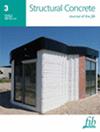Axial and bending behavior of GFRP bar‐reinforced hollow‐core polypropylene fiber concrete columns
IF 3.3
3区 工程技术
Q2 CONSTRUCTION & BUILDING TECHNOLOGY
引用次数: 0
Abstract
This study reported the axial (concentric and eccentric) and bending (four‐point bending) loadings behavior of glass fiber‐reinforced polymer (GFRP) bar‐reinforced hollow‐core polypropylene fiber concrete (HC‐GFRP‐PFC) columns. The confinement effect of HC‐GFRP‐PFC columns with different center‐to‐center (c/c) spacing of GFRP spirals was also investigated. Twelve hollow‐core circular specimens with an outer diameter of 214 mm and an inner (circular hole) diameter of 56 mm were experimentally investigated. Four reference specimens were cast with nonfibrous (normal) concrete, whereas the remaining eight specimens were cast with polypropylene fiber (0.15% by volume of concrete) concrete. It was found that, with a similar ratio of reinforcement, the HC‐GFRP‐PFC specimens gained 2%–4% higher maximum load (GFRP 棒材加固空心聚丙烯纤维混凝土柱的轴向和弯曲行为
本研究报告了玻璃纤维增强聚合物(GFRP)棒材增强中空芯聚丙烯纤维混凝土(HC-GFRP-PFC)柱的轴向(同心和偏心)和弯曲(四点弯曲)荷载行为。此外,还研究了不同中心到中心(c/c)间距的 GFRP 螺旋形 HC-GFRP-PFC 柱的约束效应。实验研究了 12 个外径 214 毫米、内径(圆孔)56 毫米的空心圆形试样。四个参考试样采用无纤维(普通)混凝土浇筑,其余八个试样采用聚丙烯纤维(占混凝土体积的 0.15%)混凝土浇筑。研究发现,与 GFRP 钢筋加固的空心无纤维混凝土(HC-GFRP-NFC)试样相比,在类似的配筋率下,HC-GFRP-PFC 试样在同心轴向荷载和四点弯曲下的最大荷载(PMaximum)高出 2%-4%,延性(μ)高出 9%-19%。在不同加载条件下,GFRP 螺旋间距为 30 mm c/c 的 HC-GFRP-PFC 试样比 GFRP 螺旋间距为 60 mm c/c 的 HC-GFRP-PFC 试样的 PMaximum 高 6%-36%,μ 高 4%-59%。
本文章由计算机程序翻译,如有差异,请以英文原文为准。
求助全文
约1分钟内获得全文
求助全文
来源期刊

Structural Concrete
CONSTRUCTION & BUILDING TECHNOLOGY-ENGINEERING, CIVIL
CiteScore
5.60
自引率
15.60%
发文量
284
审稿时长
3 months
期刊介绍:
Structural Concrete, the official journal of the fib, provides conceptual and procedural guidance in the field of concrete construction, and features peer-reviewed papers, keynote research and industry news covering all aspects of the design, construction, performance in service and demolition of concrete structures.
Main topics:
design, construction, performance in service, conservation (assessment, maintenance, strengthening) and demolition of concrete structures
research about the behaviour of concrete structures
development of design methods
fib Model Code
sustainability of concrete structures.
 求助内容:
求助内容: 应助结果提醒方式:
应助结果提醒方式:


